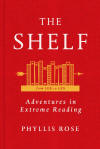The Shelf: From LEQ to LES
The premise to Phyllis Rose’s most recent book is both compelling and fantastic. “Believing that literary critics wrongly favor the famous and canonical—that is, writers chosen for us by other—I wanted to sample, more democratically, the actual ground of literature.” One part literary criticism, one part memoir, and one part exploratory narrative, The Shelf: From LEQ to LES, Adventures in Extreme Reading is a vivid experiment in how to read and a challenge to read well.
The premise to Phyllis Rose’s most recent book is both compelling and fantastic. “Believing that literary critics wrongly favor the famous and canonical—that is, writers chosen for us by other—I wanted to sample, more democratically, the actual ground of literature.” One part literary criticism, one part memoir, and one part exploratory narrative, The Shelf: From LEQ to LES, Adventures in Extreme Reading is a vivid experiment in how to read and a challenge to read well.
What would such a challenge look like? “I chose a fiction shelf in the New York Society Library somewhat at random—it happens to be the LEQ-LES shelf—and set out to read my way through it.” Just as one would scope beta for a backcountry rock climbing route or obsess about an off-piste snow profile, Rose sets conditions for The Shelf’s extreme read: the shelf in question must contain an unread classic; it must not have any books by authors that she, personally, knows; and it can have no more than four books by a single author. The shelf might be random, but the selection and reading of the books is anything but haphazard.
The bookshelf is a particularly poignant object for such an experiment in reading. It’s an object that is both an anticipation and an expectation. A shelf reflects a particular worldview and order, whether it’s the Dewey decimal system in “the stacks,” statistician Nate Silver’s rather famous chromatic arrangement of tomes in his New York apartment, or the haphazardness of a four-year-old arranging picture stories. The bookshelf, itself, is how and where we create categories to sort knowledge and experience—a linear cabinet of printed curiosities. Rose’s literary experiment takes that seemingly innocuous material object—The Shelf—and turns it into a call to literary adventure.
The Shelf is organized around questions of feminism, historical contingency, to say nothing of how literature changes and evolves. Rose describes conversations with some of the authors and references the most unexpected—details about the life and times of Gaston Leroux, statistics about the representations of women in literature, books that are met as undiscovered friends, and books that are endured. All in the space of four linear feet.
If the shelf is the organizing material object for the book—literally and metaphorically—then it begs the question of what was on it. Books, obviously, but the life history of a shelf is iterative. It’s dynamic. One of the most interesting observations that Rose offers is the realization that her experiment—that she, personally—had an effect on what was kept on the shelf and for how long. The books and shelves are not static entities, but objects in motion that depend on the library’s circulatory system. In “Libraries: Making Space,” Rose describes the CREW process at Wesleyan University—Continuous Review Evaluation and Weeding.
So many factors affect a novel’s chances of surviving, to say nothing of its becoming one of the immortal works we call a classic: how a book is initially reviewed, whether it sells, whether people continue to read it, whether it is taught in schools, whether it is included in college curricula, what literary critics say about it later, how it responds to various political currents as time moves on. We like to think that merit is eventually recognized, that a great book will make its way, but we know only the success stories.
Thanks to Rose’s empathetically clinical description of CREW, we learn that if you want to “save” a book—to buy it more time on its shelf—the best thing you can do is check it out. In a bit of ironic snark, Rose observes that one’s crusade to save books doesn’t necessitate actually reading them, just checking them out of the library.
A shelf—whether her shelf or any other shelf in any other library—is inherently dynamic. A library shelf is dependent on the decisions and use patterns of those interacting with it; it is an object whose identity is constructed by a series of decisions. Out of curiosity, I went to the local library in Austin to see what books overlapped on shelves in the LEQ-LES range. I was shocked to find that there wasn’t a single shared book between the two shelves—each shelf was its own, unique object, and shaped by the decisions of its own library.
The Shelf: From LEQ to LES, Adventures in Extreme Reading asks us to think about reading. It asks us to think about underlying assumptions that we make about how to make sense of what we read. How do we think about literature as “good” and “bad?” What makes some writing good and other writing atrocious? How ought we to think about a book—or author’s—success? The legacy of the book’s appeal? How long a copy stays on a shelf? (And to that end, what kind of shelf life—literally—would constitute success?) And how do different audiences read these authors so differently?
The Shelf is a compelling literary criticism and adventure memoir. It laughs at itself and it tells unexpected histories. It has a serious fixation with the literary prowess of Grace Paley. It relishes the occasional deadpan comment. It dares to call a book dull and relish the honesty of such an assessment. But it is humble, slightly self-deprecating, and empathetic. It celebrates reading and the art of reading well—and it celebrates it wonderfully. The Shelf is everything that one wouldn’t think to expect in the story of reading a material object.





